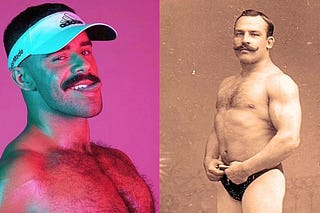
If you've ever stumbled upon a vintage photo online—perhaps a glamorous drag queen from the 1920s or a candid snapshot of an intimate moment from the 1970s—you know the thrill of uncovering a hidden gem.
But as we all know, the internet can be a bit like playing a game of telephone. As photos get shared around the internet, from X/Twitter to Tumblr to Pinterest to Instagram and more, the context and stories behind them are getting deleted and distorted, so it’s getting harder to know what's true and what's not.
INTERNET TREASURE HUNT = WHERE TO START?
When it comes to vintage photos, the internet is a goldmine. Sites like Tumblr and Pinterest are filled with gorgeous images, but they often come with little to no context. Flickr is a fantastic resource too, especially for those who love diving into meticulously curated collections by dedicated archivists.
Then there are museums and historical sites that have digitized their archives, offering a more reliable (but still sometimes incomplete) source of information.
There are so many blogs, platforms, and sites…filled with so many great images!
But here’s where it gets tricky. Not every photo you find comes with a neat little label saying, “I’m the original!” In fact, many of these images have been reposted, edited, and re-captioned so many times that the original source has been lost to time.
And when it comes to preserving LGBTQ history, this is a problem without a solution. Because we’re all too very human. Few of us are consistently good at passing along information. And even if we are…is the information we’re passing along accurate?
KEEPING THE STORY ALIVE = BEST PRACTICES
So, how do we keep the story of these vintage photos going without letting the details slip away? Here are a few best practices:
TRACE THE SOURCE
Before sharing a vintage photo, do some detective work. A reverse image search can help you track down the original source, or at least get closer to it. Look for the earliest instance of the image online—this could give you a clue about its origins.CHECK THE CONTEXT
Pay attention to the caption and any accompanying text. Does it sound like it was written by someone knowledgeable, or does it seem more like a game of “I heard it from a friend who heard it from a friend”? Trust your instincts here.VERIFY WITH TRUSTED SOURCES
If you find a photo on a blog or a lesser-known site, cross-reference it with more established sources like museums or historical archives. These institutions often have the resources to verify the authenticity and context of the photos they share.CREDIT WHERE CREDIT’S DUE
Whenever possible, it’s best to credit the original source. If you know it. If you can’t (and you won’t risk permanent suspension by say YouTube) maybe share where you found it (if you remember). And invite others to contribute whatever information they might have. There’s a reason Reddit and forums remain popular.PRESERVE THE CONTEXT + STORY
If you come across a photo with an interesting backstory, write it down! Even if it’s just a few sentences, you’re helping to preserve that piece of history for the next person who comes across it. What happens afterwards is anyone’s guess.
ON FELLOW COLLECTORS + REPOSTERS
It’s not always easy to tell a collector/reposter from an original source, but there are a few telltale signs. Original sources often provide more context—details about the at or photo, where it came from, who’s in it, and why it’s significant.
Collectors and reposters, on the other hand, might share the image with little to no information, or they might offer up a generic caption (or hashtage) that may or may not match the photo.
When in doubt, do a little digging. Use reverse image searches whenever possible.
Even if you don’t find the original source, you might uncover more about the photo’s history—and that’s always worth the effort.
KEEPING HISTORY ALIVE
In the end, preserving LGBTQ history through vintage photos is a labor of love, but it’s also a responsibility. Every time I share a photo, I try to remember I have an opportunity to add to or even correct the story. Not that I always do, but I do my best to share photos work sharing. Context and stories optional.
The next time you find that perfect vintage portrait or snapshot, take a moment to honor its history—and help keep the truth alive in this digital age of telephone.
Thanks for reading!
Clint
VINTAGE PHOTOS




























